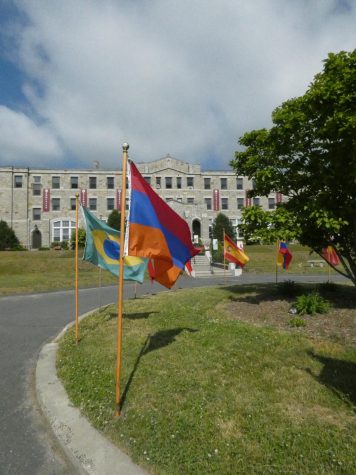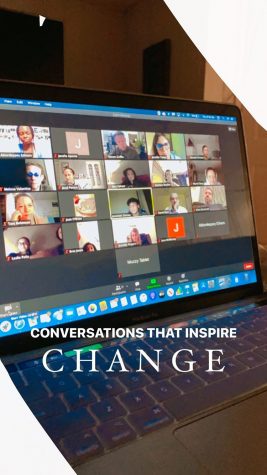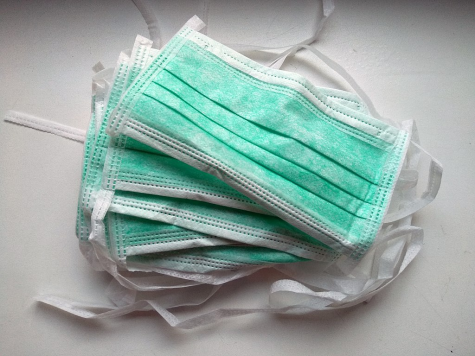The Struggles of Online Learning
November 6, 2020
We are living through unprecedented times. Even in the midst of a pandemic, The MacDuffie School is determined not to let COVID-19 affect students’ ability to learn, whether it be in-person or remote. With our school split up between students and faculty who are remote and in-person across a plethora of different time zones, people fail to acknowledge that some students are at a severe disadvantage, and advantage, when it comes to learning, and the effects coming back to school have on everyone’s families.
With students and faculty coming back to school, MacDuffie has implemented many regulations that everyone must follow to maintain a safe learning environment. Students and faculty who have chosen to come back to school are required to follow all the regulations, which include wearing a mask while around others and maintaining social distancing at all times. There are also assigned seats in all classes and assigned sections of the school (i.e. student center, computer lab) to spend free blocks.
Although in-person learning is different from the previous years, in-person learning is still the most beneficial when it comes to a student’s education. In-person students are able to learn in classrooms giving them an advantage when it comes to their education. It is evident that learning from a teacher who is in front of you, who is able to explain and show you the material, helps you learn and retain more knowledge than learning from a screen. In-person students are able to do physical activities when it comes to learning, such as labs, which helps them better understand the curriculum through hands-on activities that remote students are incapable of having.
Both in-person and remote students have to learn a similar curriculum from the previous years in a short amount of time. The current pandemic has caused the school to be more careful about the amount of time students are spending at school each day. Additionally, they have given students added time to get to and from classes. MacDuffie has increased the passing time from 5 minutes to 10 minutes, since the school now has designated stairwells to travel up or down. This helps to maintain social distancing at all times.
With this increase, students have three 55-minute classes a week, as opposed to the four 50-minute classes each week they had in previous years. Although it may not seem like a disadvantage, those class times they miss each week add up over the course of a school year. The missed class time adds up to approximately 36 hours per class, for the entire school year. However, MacDuffie has still been working to make sure students who are having trouble keep learning to the best they can. Two Extra Help sessions have been added to accommodate time zones, each extra help session is one hour long, and they take place Wednesday mornings and evenings.
Although in-person learners have to get used to a whole new way of learning, remote students have to face many adversities when it comes to their education. Many students choose to study remotely because of safety concerns or travel bans. So while many families feel that it is a safer choice to study remotely, these students who choose to study remotely opt out of the school’s full academic program. What this means is that remote students are excluded from certain opportunities like in-person classes, sports, CAP’s, theater, and even taking the PSAT.
Students who choose to learn remotely are in a video call for their classes through Zoom, a video conferencing website. This can often make it more difficult to stay focused for the duration of a class, along with simple distractions that remote students have, like dogs barking, or noisy distractions on their street. Along with not being able to have the same opportunities as in-person learners, remote students must also deal with certain obstacles that come along with learning online. Some of these include poor internet connection, being unable to hear the teacher and/or other students, and not being able to do labs.
Some students are in completely different time zones, up to 12 hours different from the local time in Granby. This requires some students to watch videos of the classes, which are much less interactive and doesn’t give those students the opportunity to ask questions as they go along. Additionally, some of these students stay up until 3 am for their classes and assessments, which provides a huge challenge for their learning.
Although in-person and remote learning affects students’ education, people fail to recognize how teachers and faculty members are adjusting to the new way of teaching and the toll it takes on them. Teachers and faculty members have to abide by the same rules and regulations that students do. Along with the new rules, they must also adjust to teaching both in-person and online students at the same time, which makes it significantly harder to help everyone to learn the same material.
Another element that many people may overlook is the fact that each of these faculty members must balance their own personal lives with teaching. Given the pandemic, many faculty members have school-age children who are learning remotely that they must help. Because of this, there are certain faculty members who are teaching remotely and in-person, each for different parts of the week.
There is also the challenge of assessing students through tests and quizzes.
“If I’m trying to maintain a tighter testing environment for the people in front of me, which is easy to do, I can’t guarantee that same thing is happening for the remote students,” said History Teacher Dave Denno.
Every faculty member interviewed noted that there is a big level of trust between them and every remote student when it comes to assessments. Teaching during the pandemic has proven quite a challenge for everyone involved, but as more information is discovered and everyday life during the pandemic becomes more routine, things will continue to improve.
Even though there has been so much uncertainty throughout the school year thus far, improvements continue to be made. The best thing that can be done at this point in time is to stay safe, stay healthy, stay happy, and do whatever is safest and best for you and those around you. The safer the environment we have, the more health and safety improvements that are made. While the future is uncertain, we’re doing all that we can to try and make this better, and soon enough… it will be.



